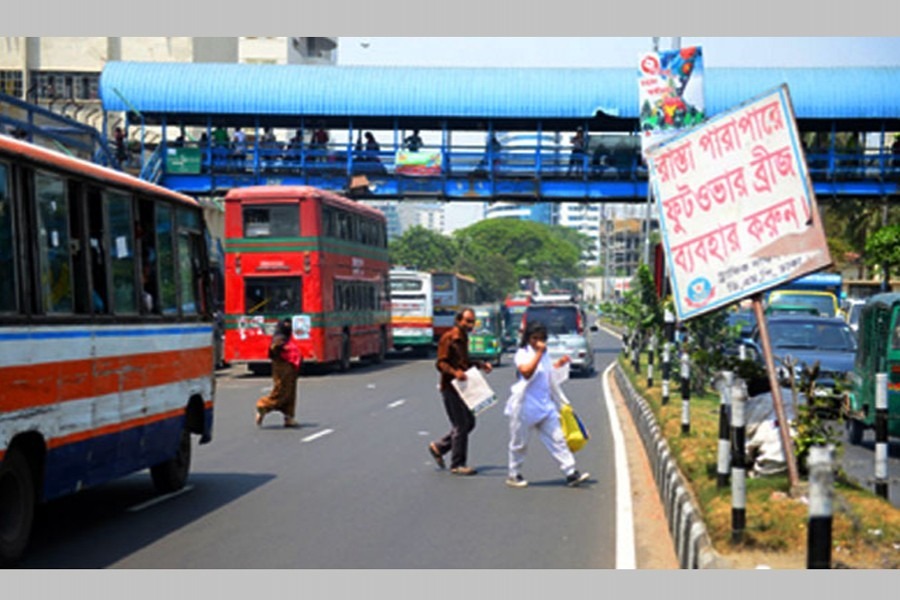
Published :
Updated :

Omar climbed up and down the stairs of a footbridge to go across the road at the Science Lab intersection for years. But with ageing, his knees began protesting.
He slowed down his pace first, then moved to the railings for support and then stopped using the footbridge altogether about two years ago. Because that seemed as daunting as participating in a marathon would be for a normal, functional human being.
This scribe narrated the experiences of people like Omar to many around her, but received sarcasm in response to her realisation that Dhaka was and still is a city meant for people ready to fight to survive. That explains the insensitive attitude towards the weak -- the elderly, the physically challenged and the children. The media also have not brought up the issue. Instead, it hammered on breaches of traffic rules, such as jaywalking, without looking at underlying reasons.
Of course, there are people who violate rules on the streets. Jaywalkers are among those but many of them cannot abide by what is legal. Not because they are unruly but because they are physically incapable.
The world has come far from the perception that it is a place only for the "survival of the fittest". It originated from Darwin's theory of evolution, but humans have long overcome the natural barriers through innovations and propagated the ideas about equality, equal rights and that all lives matter.
Cities across continents have changed their infrastructure and civic amenities, keeping in mind those who are the most vulnerable. When policies reflect kindness towards the weak, people tend to emulate those. Thus, a place with swanky buildings acquires humane qualities.
What could we have done? The simple answer is making zebra crossings functional, which have been reduced to patches of fading white lines on roads in the capital. But is that it? No. The policymakers should run campaigns to make drivers, riders, and pedestrians sensitive towards good civic practices and that one must make daily commutes safe and pleasant for others.
We can see progressive reforms in transport and communication in emerging countries, such as Sri Lanka, India and Thailand.
In developed countries, such as Singapore, safety is above everything else. If an old man or woman is in the middle of a road when the green signal turns red, vehicles will not be closing in on them and threaten to knock them over for traffic rule violation. In the UK, this scribe has seen buses and cars refrain from making an inch forward until those on one end of a zebra crossing get to the other end. After all, rules are meant for people. Not the other way around.
Dhaka is a city of 10.2 million people, according to the Population and Housing Census 2022. Since 9.28 per cent of the population are above 60 years, the absolute number of them is about 0.95 million in the capital. Increasing life expectancy would only expedite the growth of the elderly people. At the same time, we have physically challenged people and children.
The city must create a congenial environment so adults can contribute to the social and economic development, while children can flourish - physically and intellectually. Confining them to homes for the sake of safety will have damaging consequences, and a country looking to graduate from the status of Least Developed Country will not reach the goal only by attaining some financial numbers.
Improving mobility is important. In doing so, while infrastructures, such as mass rapid transit, have ushered in a new era, the city needs to make small steps too, which can transform our chaotic transport system in a big way.
A solution to a problem that requires less investment but rigorous awareness campaigns is not a big ask. In the process, our sense of responsibility as city dwellers will achieve depth, making us more civilised.
devnathbishakha@gmail.com


 For all latest news, follow The Financial Express Google News channel.
For all latest news, follow The Financial Express Google News channel.